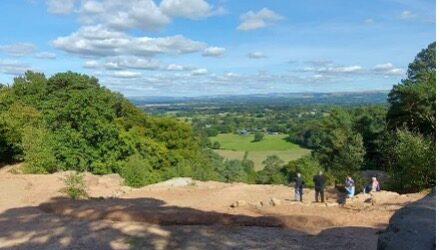Caroline Hoare and Gary Bitcliffe led the very successful Alderley Edge Pilgrims Day on the 17th of September. Here is their report of the day:
 The group was first taken to the entrance of one of the oldest sites of mining at Alderley Edge called Engine Vein, located behind the Wizard Tea Room courtesy of Bill, one of the Alderley Edge wardens.
The group was first taken to the entrance of one of the oldest sites of mining at Alderley Edge called Engine Vein, located behind the Wizard Tea Room courtesy of Bill, one of the Alderley Edge wardens.
It contains traces of Bronze Age workings and beneath the Edge are a vast network of tunnels and shafts, caverns and underground pools. The Bronze Age peoples and the Romans mined the rich copper seams and minerals within highly crystalline sandstone.
 Further along the path we came to the ‘Golden Stone’, the name deriving from the colour of the aura that it gives off.
Further along the path we came to the ‘Golden Stone’, the name deriving from the colour of the aura that it gives off.
This large misshapen pebbly sandstone boulder marks the Belinus alignment.
A worn spot on the top of it is perhaps due to former pilgrims placing their feet or hands there as a form of worship or veneration.
 A gateway near the stone led us to the inner sanctum of this densely wooded ridge, once abundant with Alder trees.
A gateway near the stone led us to the inner sanctum of this densely wooded ridge, once abundant with Alder trees.
The name ‘Alderley’ derives from this ancient tree that was once sacred sacred to the early cultures of northern England.
We came to a high ridge known as Stormy Point with amazing views over the East Cheshire landscape. Here, we first encountered Elen, the female serpent energy of the Spine of Albion.
A local tale says that a witches’ coven used to regularly meet here and was witnessed by a local newspaper reporter in the 1960s, clad in white robes and walking sunwise around a large fire.

 Taking narrow gnarled paths covered in tree roots we descended further into the woodland where we found two holy wells below a steep slope, nicknamed by Caroline and Gary as the ‘Elen Wells’.
Taking narrow gnarled paths covered in tree roots we descended further into the woodland where we found two holy wells below a steep slope, nicknamed by Caroline and Gary as the ‘Elen Wells’.
Nine separate wells once existed around the Edge renowned for their healing qualities.

 We then follow a path with several sandstone outcrops to another holy well known as the Wizard’s made famous by local author Alan Garner in his novel The Weirdstone of Brisingamen (1957).
We then follow a path with several sandstone outcrops to another holy well known as the Wizard’s made famous by local author Alan Garner in his novel The Weirdstone of Brisingamen (1957).
Above the well is a 19th century carving of a wizard’s head and the words ‘Drink of this and take thy fill for the water falls by the Wizard’s will’.
Here we find Belinus, the male current of The Spine of Albion and interestingly this site is associated with a legend that King Arthur and his knights lie sleeping within a hidden cave ready to come to Britain’s aid during its hour of need.
 Nearby is another ridge called Castle Rock with superb views of the city of Manchester in the distance. Elen and Belinus form a Node here where in medieval times the Earl of Chester’s stonemasons tried without success to build a castle.
Nearby is another ridge called Castle Rock with superb views of the city of Manchester in the distance. Elen and Belinus form a Node here where in medieval times the Earl of Chester’s stonemasons tried without success to build a castle.
 As we were leaving the interior heading for the Wizard Tea Room for a well-earned cup of tea, Gary and Caroline veered off the path to show us a wide cave mouth, which they saw as symbolic of the cave where Arthur and his knights lie sleeping.
As we were leaving the interior heading for the Wizard Tea Room for a well-earned cup of tea, Gary and Caroline veered off the path to show us a wide cave mouth, which they saw as symbolic of the cave where Arthur and his knights lie sleeping.
It is in fact the entrance of Church quarry although we preferred the romantic version.
